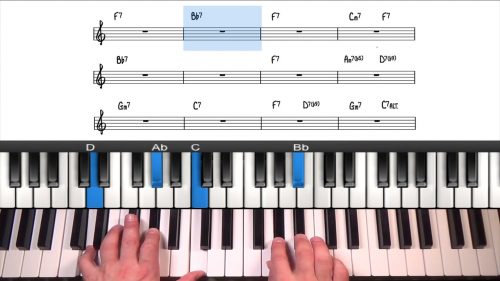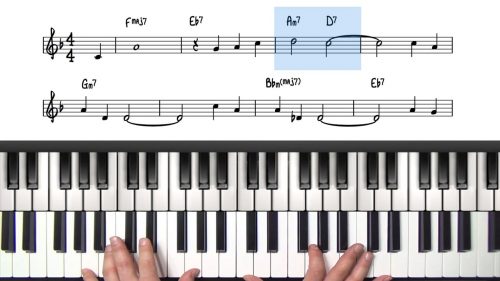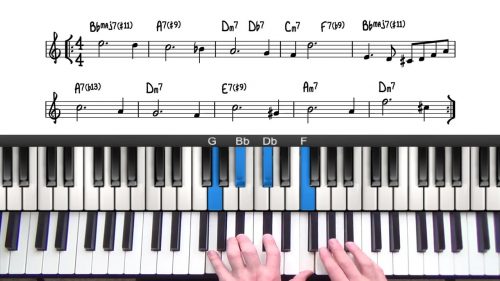Useful Features Of Transcribe Software
In this lesson we explore 2 useful features of the Transcribe Software that will help you with transcribing chords and improvised lines.
If we click on the “View” dropdown menu in the top left and you will see 2 options in that menu, these are “Show Note Guesses” and “Show Chord Guesses”.
Show Chord Guesses
If we click this option, we see a box appear on the middle right of the screen.
This box gives you an analysis of the harmony and it’s good to look here before you start working out the notes of a line to make sure the chords haven’t been rehamonised from the original changes.
The software analyses bass note and other important notes to give you the jazz chord name. You will notice that sometimes it says “spectrum too messy” in which case it won’t give you a chord guess but if you rewind and try pausing the video a split second before or after. Sometimes it will pick something up.
Show Note Guesses
When you turn this option on, you will notice that some of the keyboard keys light up green and red. The accuracy of this tool can vary, and it also depends on the quality of the recording. If the sound is very crisp and clean, then it tends to pick up the notes better.
It’s useful for identifying the individual notes of improvised lines and it’s also handy for seeing the bass note. If the chord voicing contains lots of notes, you will find that the centre of the keyboard is often very cluttered and so it can be hard to take anything away from this.
Practice Tips
-
It’s important to remember that these 2 features are an additional aid, and so try not to become completely reliant on them. They are useful if the harmony has changed,
- Also remember that these features will just give you the notes and harmony. The main purpose of transcription is to absorb the rhythm and phrasing and to do that you need to use your ears and play along with the record.





I agree, Hayden, that the process of transcribing music is both very useful and very, very educational. Before I joined PianoGroove, I came across Finale Music Notation software (I found a free version on the internet that is very simple but also easy to learn). That helped me write out, in full, chords and/or solos, licks, runs, etc. Very, very useful to do this slowly, understand the process fully and, as young folks say “own it” at the end. Makes playing and improvisation later on so much easier.
I think I understand how Transcribe works and put it on my list of things to turn to next. In the meantime, I am relying on transcripts you post, or others that can be found on the internet, to study them thoroughly and apply whenever appropriate.
Thanks, Smole
Hello Hayden, i have many problems using Transcribe, i tried to analyse some records such as My foolish Heart, Bill Evans version or My Sentimental Mood of The Duke with Coltrane but the software gives different chords than the sheet music (and i have the same key as they play in) and if i try analyzing the same chord several times, the software gives me a different chord each time. I really don’t feel comfortable with this, do i really need to use this software to improve my ear or can i transcribe solos without it ?
Cheers, Guillaume
Hi Guilaume,
Firstly to answer your question, no, you do not need to use this software to improve your ear. This software is an additional aid, and if you can do it without the software then even better!
To explain why you will see lots of different chord symbols:
1) Jazz standards are often reharmonised by different players. We don’t all use the same chords. That’s why everyones’ arrangements are unique, and that is one of the beauties of jazz music… we can choose what chord to play, change chords etc… That’s just part of jazz.
2) In jazz music, 1 chord, or a ‘one set of notes’ can function as many different chords. For example, if we take the notes Eb-G-A-D – that could be many rootless voicings in jazz piano. It could be F13 (b7-9-3-13), it could be the tritone B7#5#9 (3-#5-b7-#9), it could be C-69 (b3-5-6-9). Those exact 4 notes – Eb-G-A-D – could also be voicings containing the root such as Ebmaj7#11 (root-3-#11-7) or even an inversion of A-11b5 (b5-b7-root-11)
3) Taking the above into consideration, Transcribe is just a piece of software. It doesn’t have a brain like me and you 🙂 and so it can’t always understand the exact chord being played. It does a very good job, but it’s not perfect. This ties into the first point I mentioned. We should just use this software as an aid, to help us if we need to, but really the best way is to transcribe directly by ear from the recording.
For me personally, I find these features very useful. However, sometimes I do not need them, it depends how complex the music is that I am trying to transcribe.
I hope this helps, if you would like any further information just let me know.
Cheers,
Hayden